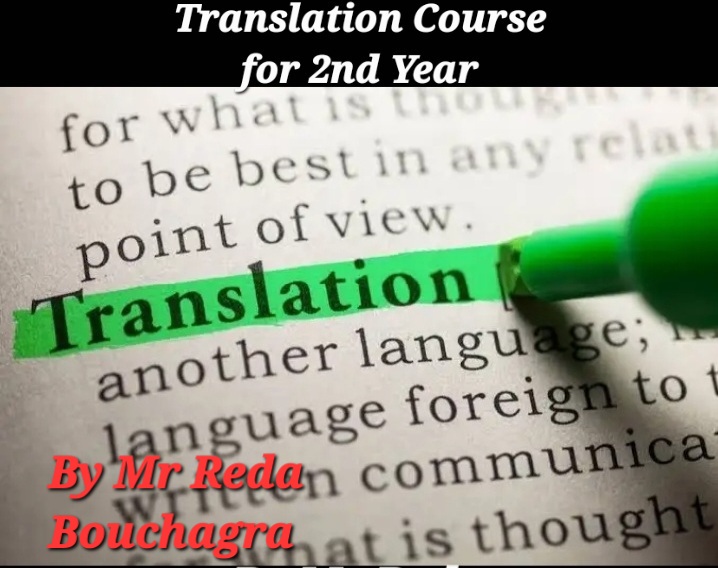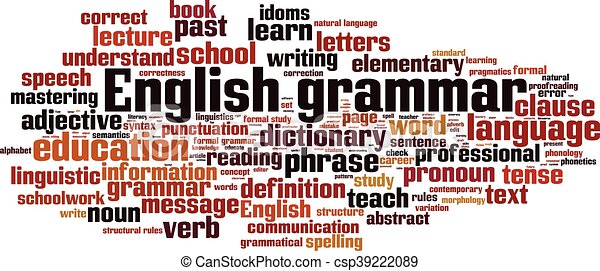This course is an introduction to the discipline of Translation it brings together the basic Translation techniques and the use of languages in a multilingual context.
- Enseignant: Reda Bouchagra
- Enseignant: rida sellali

- Enseignant: soumia Guettala
The teaching of grammar is skills- integrated as it involves both oral and written skills. With this method, we hope to shift the way students view grammar. Grammar accuracy should no longer be considered as an isolated element of language learning, but as an essential feature of successful oral and written communication of ideas and meaning in general.
Objectives:
By the end of the course, the students will be able to:
- Identify the basic grammatical structures of English.
- Demonstrate ability to make appropriate grammatical choices to express the intended
meanings.- Use English correctly and appropriately.
Assessment Method:
Mid-term written Test and end of term written exam.
Basic readings:
- Carter, R. , Hughes, R & M, McCarthy (2000) Exploring Grammar in context. Grammarreference& practice upper-intermediate and advanced.Cambridge: CUP
- Hewings, M (2005) Advanced Grammar in Use.CUP
- Yule, G (1998) Explaining English Grammar.OUP
- Yule, G (2005) Oxford Practice Grammar.OUP
- Enseignant: badra DRIS
The course is for intermediate ESL students. It is designed to build writing skills through authentic readings and a multi-drafting process approach to writing, in order to prepare for academic work in English. Writing exercises review paragraph organization and focus on essay construction as well as the use of formal English grammar.
Course Objectives:
Analyze an author’s point of view by making inferences.
Determine the meaning of increasingly complex passages by using contextual clues.
Use background knowledge and linguistic and contextual clues to infer the meaning of unknown words.
Draw general conclusions from specific details in a passage.
Write compositions with a clear introduction, supporting details, and conclusion.
Edit own and peers’ writing for grammatical form, word choice, spelling, mechanics, sentence variety, and organization.
Write summaries and paraphrases of reading passages.
Take notes from full-length formal presentations using graphic organizers. Student Learning Outcomes: By the end of this class students will be able to:
Use syntactic clues to interpret the meaning of complex sentences or new vocabulary. Find information by using reference tools, including online resources.
Monitor comprehension and adjust reading strategy as measured by unit reading responses, reading tests, and quizzes.
Understand the writing process and method as measured by written essays, reading responses,
and research papers.
Instructional Methods:
This is a face-to-face course, in which you will attend class and submit all classwork on time. There will be daily reading and writing activities along with group and individual projects. Preparation for the next class is strongly encouraged because the class will be conducted based on the assumption that students have prepared for the class. Moreover, students need to become accustomed to the habit of preparation because all university classes require reading books or papers before the class; professors anticipate that students bring up questions about topics.
Student Responsibilities:
Students are expected to be prepared for class by doing all assigned reading as well as
weekly homework assignments to be completed outside of class. Homework must be
turned in on time. No late work will be accepted.
When you miss class for any reason, you are still responsible for the information presented and
assignments given in class. Due dates remain the same whether you are in class or not.
Contact a fellow student and the teacher for missed assignments.
Academic Integrity
Students are expected to maintain high standards of
integrity and honesty in all of their scholastic work. This means that any essay that is copied from a friend and from an online source will result in a zero grade point.
Syllabus Change Policy
The syllabus is a guide. Circumstances and events, such as student progress, may make it
necessary for the instructor to modify the syllabus during the semester. Any changes made
to the syllabus will be announced in advance.
Materials
1. Swales, J. M., & Feak, C. B. (2012). Academic Writing for Graduate Students: Essential Tasks
and Skills (3rd ed.). Ann Arbor, MI: University of Michigan.
2. Elbow, Peter. (1998). Writing With Power: Techniques for Mastering the Writing Process. Oxford University Press.
- Enseignant: Sami Berbache
Course objectives: By the end of the course, students are expected to meet the following learning objectives: - Understand the concepts underlying major linguistic theories, schools, and movements. - Develop critical thinking, analyze and synthesize relevant linguistic information. Demonstrate a fairly good mastery of English.
Assessment Method: Mid-term test and final examination
Basic Readings:
- Crystal, D (1971) Linguistics. London: The Penguin Group.
- Lyons, J. (1981) Language and Linguistics: An Introduction. Cambridge: CUP. - Polsky, B (2012) Sociolinguistics.Oxford: OUP
- Robins, R.H (1967)A Short History of Linguistics. London: Longman Group Limited. Trudgill,P (2000) Sociolinguistics: An Introduction to language and Society. Penguin
- Enseignant: Soussen BOUKHENNOUFA

This module is an Introduction to Translation practices. It aims at equipping English Language students with the necessary tools to improve the understanding of other languages for the purpose of becoming researchers.
Stay Tunned and you will like to follow this module.
Mr Bouchagra
Bibliography for further reading:
Holmes, James S. (1972/1988). The Name and Nature of Translation Studies. In Holmes, Translated!
Papers on Literary Translation and Translation Studies, Amsterdam: Rodopi, pp. 67–80.
Munday, Jeremy. 2008. Introducing Translation Studies. London and New York: Routledge. p 4
Cary, Edmond.1959. '"AndréiFédorov.Introduction à la théorie de la traduction." Babel 5, p19n.
Munday, Jeremy.2008.Introducing Translation Studies. London and New York: Routledge. pp. 8
Vinay, Jean-Paul and J.Darbelnet.1958/1995. Comparative Stylistics of French and English: A
Methodology for Translation. Amsterdam and Philadelphia: John Benjamins.
Nida, Eugene. 1964. Toward a Science of Translating. Leiden: EJ Brill.
Catford, J.C., (1965). A Linguistic Theory of Translation. London: Longman.
Levý, Jiří (1967). Translation as a Decision Process.In To Honor Roman Jakobson. The Hague: Mouton,
II, pp. 1171–1182.
Toury, Gideon (1995). Descriptive Translation Studies and beyond. Amsterdam and Philadelphia: John
Benjamins.
Lederer Marianne (2003). Translation – The Interpretive Model, Manchester: St. Jerome.
Even-Zohar, I. (1990b) "Polysystem theory," Poetics Today 11(1): 9-26 LINK
Hermans, T. (ed.) .1985. 'The Manipulation of Literature: Studies in Literary Translation'. London and
Sydney: Croom Helm.
Lefevere, A. 1992.'Translation, Rewriting, and the Manipulation of Literary Fame'. London and New
York: Routledge.
Reiss, Katharina (1989). "Text Types, Translation Types and Translation Assessment." In: Chesterman,
Andrew (ed.) (1989). Readings in Translation Theory. Helsinki: Finn Lectura
Pym, Anthony. 2008. Exploring Translation Theories. London and New York: Routledge. 47
- Enseignant: Reda Bouchagra

